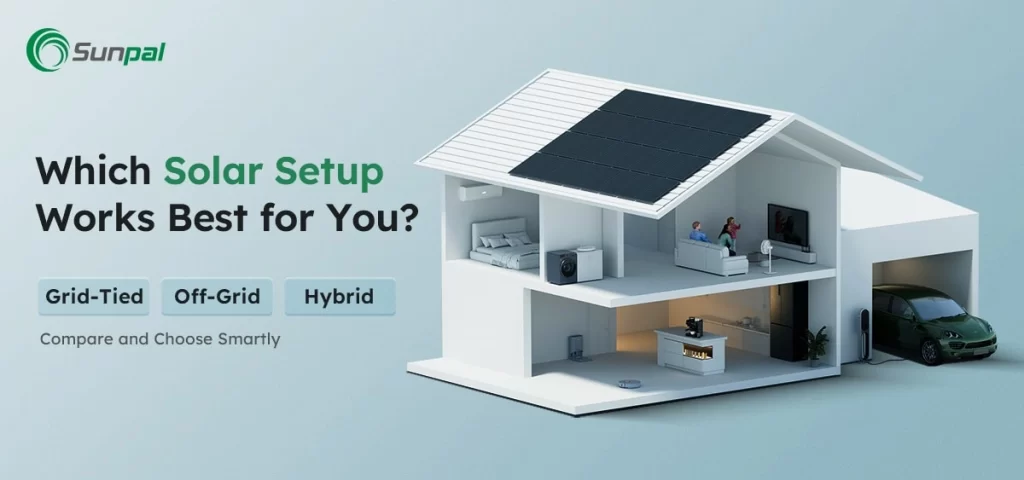
What's the smartest solar setup for your energy goals—grid-tied, off-grid, or hybrid? As solar adoption accelerates across residential, commercial, and industrial sectors, the decision isn't just about going solar—it's about selecting the system that aligns with your location, energy usage, and budget strategy.
This article breaks down the key types of solar energy systems, compares their technical and financial performance, and explores where each solution makes the most sense—so you can make a data-driven investment in solar infrastructure.
Understanding the Three Main Solar System Types
Grid-Tied Solar Systems: Simple and Cost-Efficient
A grid-tied solar system connects directly to the utility grid. It supplies power during sunlight hours and imports electricity from the grid when solar production is insufficient. Any excess generation can be fed back to the grid through net metering, reducing your electricity bills.
Best For:
Businesses, warehouses, and homes in areas with reliable grid power.
Highlights:
- Low upfront investment
- Net metering savings
- Minimal maintenance
Limitation:
No backup power during outages unless paired with a battery system.
Off-Grid Solar Systems: Full Energy Independence
Off-grid systems operate independently of the utility grid. They combine solar panels with battery storage and often a backup generator to ensure continuous power, even at night or in bad weather.
Best For:
Remote industrial operations, agricultural sites, or areas with no grid access.
Highlights:
- Total energy autonomy
- No utility bills
- Ideal for remote locations
Limitation:
High initial investment and battery management required.
Hybrid Solar Systems: Reliable, Flexible, and Resilient
Hybrid systems combine the grid connection of a grid-tied system with the backup capabilities of off-grid storage. With a hybrid inverter and lithium battery storage, these systems automatically switch power sources during grid outages or peak tariff periods.
Best For:
Facilities requiring uninterrupted power—e.g., hospitals, data centers, and manufacturing.
Highlights:
- Energy security during blackouts
- Time-of-use optimization
- Intelligent energy management
Limitation:
Higher equipment cost and slightly more complex design.
Technical Comparison: Key System Attributes
To help businesses choose the right setup, here's a comparison of essential system characteristics:
Chart 1: Feature Comparison of Solar Energy System Types
| Feature | Grid-Tied | Off-Grid | Hybrid |
| Grid Connection | Sí | No | Sí |
| Battery Storage | Opcional | Required | Required |
| Backup Power | No | Sí | Sí |
| Upfront Investment | Bajo | Alta | Medium–High |
| Ideal Application | Urban areas | Remote areas | Power-sensitive |
| Net Metering Available | Sí | No | Sí |
Financial Perspective: Cost Structure and ROI Outlook
Beyond functionality, cost is a crucial factor. While grid-tied systems offer the lowest startup costs, hybrid systems deliver long-term value through savings on peak tariffs and improved uptime. Off-grid solutions are costly but often the only option where no grid exists.
Chart 2: Estimated Cost Breakdown by System Type (USD per kW)
| System Type | Solar Modules | Inversor | Batteries | Instalación | Total Cost (Est.) |
| Grid-Tied | $600 | $250 | – | $150 | $1,000 |
| Off-Grid | $600 | $250 | $500 | $200 | $1,550 |
| Hybrid | $600 | $300 | $400 | $200 | $1,500 |
Note: Prices vary based on location, battery type, and system scale.
Real-World Use Cases: Matching Systems to Applications
Commercial Buildings
Most opt for grid-tied systems with optional hybrid backup for elevators, lighting, and IT infrastructure. Net metering cuts operational costs while battery backup ensures resilience.
Remote Operations
Off-grid systems are critical for telecom towers, mining operations, and off-the-grid agriculture—where utility access is either unreliable or nonexistent.
Industrial Facilities
Hybrid systems are ideal for load-heavy factories facing utility interruptions or peak-hour pricing. Businesses can store energy when rates are low and use it when costs rise.
Market Trend: Hybrid Systems Are Gaining Ground
With energy instability and grid vulnerability on the rise, hybrid systems are now the fastest-growing segment in the solar market. Their dual benefits—grid interaction plus backup power—make them especially attractive for businesses seeking resilience and long-term savings.
Chart 3: Global Market Growth of Hybrid Solar Systems (2020–2025)
| Year | Hybrid Installations (GW) |
| 2020 | 6.1 GW |
| 2021 | 7.4 GW |
| 2022 | 8.8 GW |
| 2023 | 10.2 GW |
| 2024 | 12.6 GW |
| 2025 (Est.) | 15.3 GW |
Source: BloombergNEF / IEA
Frequently Asked Questions (FAQ)
1. Which solar system is best for reducing electricity bills?
Grid-tied systems are typically the most cost-effective for bill reduction, especially with net metering programs. However, hybrid systems can provide additional savings by reducing peak-hour consumption.
2. Can I switch from grid-tied to hybrid later?
Yes, grid-tied systems can be upgraded to hybrid by adding a compatible inverter and battery storage. Many solar providers, including Sunpal, offer scalable solutions that grow with your needs.
3. Are off-grid systems reliable for 24/7 operations?
With properly sized lithium battery storage and backup generation, off-grid systems can reliably support 24/7 operations. They are widely used in telecom, oil & gas, and off-grid agriculture.
4. How long do solar batteries last?
High-quality lithium iron phosphate (LiFePO4) batteries last 10–15 years, with up to 6,000+ charge cycles. Battery lifespan depends on depth of discharge, ambient temperature, and usage patterns.
5. What are the main maintenance requirements for each system?
- Grid-Tied: Minimal—occasional inverter checks and panel cleaning.
- Off-Grid: Battery monitoring, charge controller upkeep, and potential generator servicing.
- Hybrid: Battery management, firmware updates, and smart inverter performance optimization.
Conclusion: Strategic Solar Choices Deliver Maximum Value
The best solar system isn't just about watts—it's about what works for your business, location, and energy goals. Grid-tied systems offer cost-effectiveness; off-grid ensures full control; hybrids deliver flexibility and backup. Each has its strengths.
Sunpal provides fully customized solar system solutions tailored to commercial and industrial needs—whether you're powering an urban office, a rural factory, or a remote telecom site.
